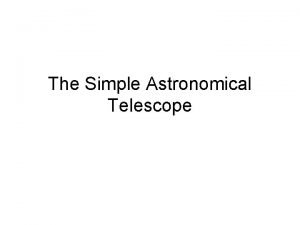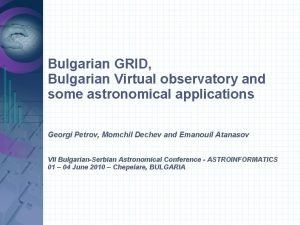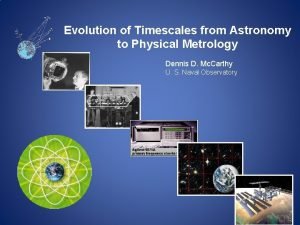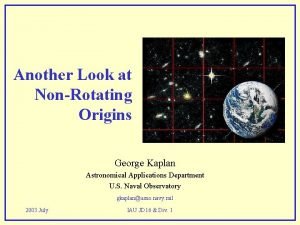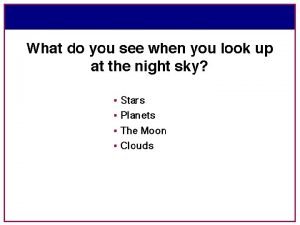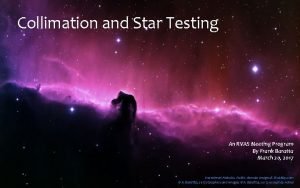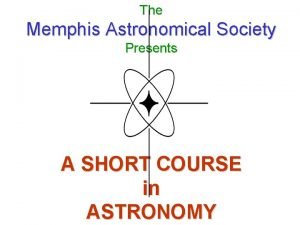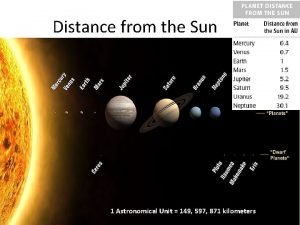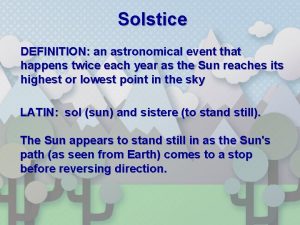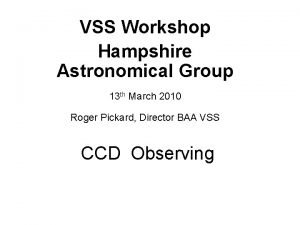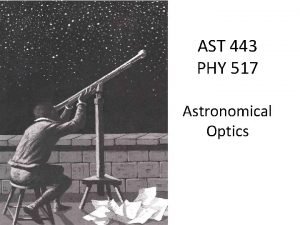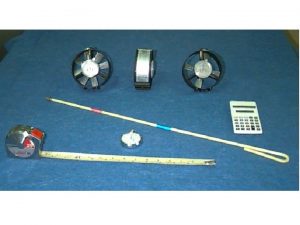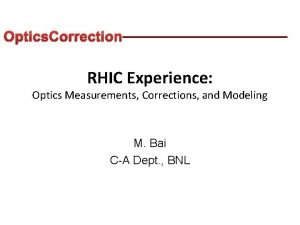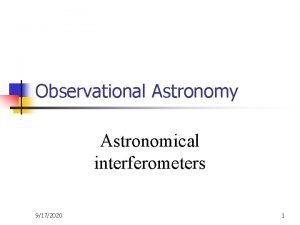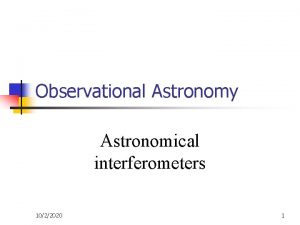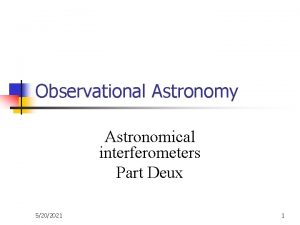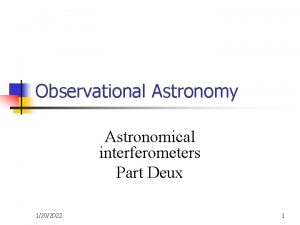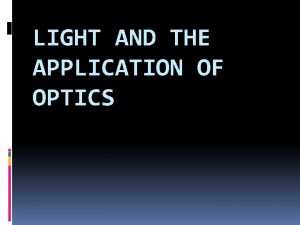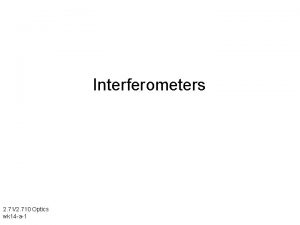Astronomical Optics 4 3 Phase correction in interferometers















- Slides: 15

Astronomical Optics 4. 3. Phase correction in interferometers OUTLINE: Phase referencing in interferometers – why phase referencing? beyond V 2 interferometry: astrometry, image synthesis, phase closure Wavefront correction on individual apertures tradeoff between calibration accuracy, efficiency and wavefront quality Technology: – delay lines – atmospheric dispersion compensation: vacuum delay lines, ADCs – Adaptive optics correction in interferometers – Calibration of residual phase errors with spatial filtering: pinhole, fiber interferometry

Delay lines Must maintain near-zero Optical Pathlength Difference (OPD) between arms of the interferometer VLTI delay line moving cart Keck interferometer coarse delay lines

Delay lines Must maintain near-zero Optical Pathlength Difference (OPD) between arms of the interferometer

Part 1: Control and calibration of visibility in interferometers

Scientific motivation Why is fringe visibility accuracy important ? Example below shows effect of fringe visibility measurement accuracy on measurement of stellar diameters (in this example, used to measure absolute distance to Cepheid stars) A. Merand, Cepheids at high angular resolution

Sources of fringe visibility loss (discussed in next slides) What can go wrong ? Why would the measured fringe visibility be < 1 on a point source ? Amplitude difference between the 2 beams Problem: If one beam is brighter than the other, fringe visibility <1 → measure flux in each arm of the interferometer Phase errors within each of the 2 beams Problem: Wavefront is not flat before entering the beam combiner → calibrate visibility loss by observing another star → good adaptive optics for each of the telescopes → spatial filtering to clean the beams, at the cost of flux Phase between the 2 beams is changing within detector exposure time Problem: Measurement is superposition of shifted fringes, with apparent V < 1 → calibrate visibility loss by observing another star → reduce / calibrate internal sources of vibration → if possible, fringe tracking on nearby bright source Phase between the 2 beams is changing within the spectral band of the measurement Problem: Dispersion in atmosphere and interferometer: measurement is superposition of shifted fringes, with apparent V < 1 → optically compensate atmospheric dispersion → calibrate visibility loss by observing another star → disperse fringes on detector → use vacuum delay lines Polarization is different between the 2 beams Problem: internal instrumental polarization in interferometer → calibrate visibility loss by observing another star → design telescopes, beam transport and delay lines to minimize differential polarization effects

Fringe visibility loss: phase errors in beams Example: 2 beams are combined with a beam splitter Each beam has phase errors, and differential phase error between the beams is ~1 rad consider 3 points in the pupil: – point 1: phase difference between 2 beams is -1 rad – point 2: phase difference between 2 beams is 0 rad – point 3: phase difference between 2 beams is +1 rad beam #1 detector (total intensity measured) beam #2 beam splitter for each of the 3 points, visibility is = 1, but phase is offset What is observed is the total flux, the sum of the 3 curves on the left Measured visibility = 0. 7 < 1. 0 problem: Is measured visibility due to aberrations, or true object visibility Same concept applies to variations of phase with time and wavelength

Fringe visibility loss: phase errors in beams Solutions to problem Visibility loss is approximately equal to Strehl ratio ~ exp(-σ2) With σ = 1 radian RMS, visibility ~ 0. 3 Good adaptive optics correction to reduce σ is essential on large telescopes Spatial filtering can be used to clean beam: Optically transforms aberrated wavefront into flat wavefront With aberrated wavefront, light is lost by spatial filtering corrugated wavefront spatial filter (pinhole or single mode fiber) flat wavefront

Spatial filtering alone does not help, as flux variations in interferometer arms are strong Photometric calibration, achieved by measuring light in both arms of the interferometer AFTER spatial filtering, can calibrate visibility loss due to flux variations. Spatial filtering + photometric calibration is powerful solution, and has achieved < % visibility accuracy on sky spatial filtering (telescope light injected in fibers) Uncalibrated signal: I 1 photometric channels: P 1, P 2 Calibrated signal takes into account mismatch between P 1 and P 2 IOTA fiber interferometer (Berger et al. 2001)

Fringe visibility loss: chromatic dispersion Atmosphere introduces strong chromatic dispersion which needs to be compensated In conventional interferometer, delay line introduces a delay (in air) to compensate for a vacuum delay → dispersion compensator is required. Problem can be mitigated by using vacuum delay lines delay = B sin θ θ atmosphere Telescope #1 Telescope #2 dispersion compensator Delay line introduces delay to equalize paths fringes

Part 2: Control and calibration of fringe phases

Fringe tracking: essential to allow observation of faint sources Throughput in an interferometer is often low, due to large number of optical elements: telescope, beam transport, delay lines, beam combiner Atmospheric turbulence and vibrations move fringes very rapidly Measurement is only possible if individual exposure time << time it takes for fringe to move by a wavelength → with no phase tracking, difficult to observe faint targets Typical limiting magnitudes for interferometers: 5 to 10 in visible / near-IR To extend this limit, one needs to track and lock fringes to allow long exposures Observations typically requires 100 -1000 Hz sampling to “freeze” the seeing. Consider fringe sensing carried out in K band (2. 0 -2. 4 microns): an 8 m aperture receives ~15, 000 photons from a K=10 star in 1 ms. sky background is ~1500 photons/ms. Telescope background is ~15, 000 photons/ms. throughput is 6%. This gives an SNR of 8 in a 1 ms exposure.

Fringe tracking Fringe tracker measures rapidly fringe position, and actively controls optical pathelength corrector (=fast delay line) at the input of the beam combiner Enables longer exposures with the scientific instrument VLTI fringe tracker shown at the upper left corner of this figure (Corcione et al. , 2008)

Phase referencing Scientific motivations Image reconstruction with multiple baselines requires measurement of phases and visibilities (with no phases, only centro-symmetric component of the image can be estimated) Astrometric measurement (measuring position of sources) requires fringe phase On a single baseline: astrometric error [rad] = phase error [rad] x ( λ / 2π ) / Baseline How to reference phase ? - or what to use as a refence A nearby star can be used to reference phase on a single baseline interferometer Phase closure relationships can be used to separate instrumental phases from object phases (see next slides) Phase can be measured as a function of wavelength: object itself (at different wavelength) provides a refence Example: Accurately measuring photocenter as a function of wavelength with an interferometer can reveal planets, as hot planet is redder than star See VLTI/Amber instrument for example photocenter (red) (blue)

Phase closures To be inserted (Phil)
 Difference between ray optics and wave optics
Difference between ray optics and wave optics Reflection and refraction venn diagram
Reflection and refraction venn diagram Guildford astronomical society
Guildford astronomical society Angular magnification of astronomical telescope
Angular magnification of astronomical telescope Astronomical
Astronomical Astronomical time scale
Astronomical time scale Astronomical applications department
Astronomical applications department Sc002 constellation chart
Sc002 constellation chart Astronomical clock lyon france
Astronomical clock lyon france Star collimation
Star collimation Memphis astronomical society
Memphis astronomical society What is an astronomical unit
What is an astronomical unit Julie ramer
Julie ramer Solstice definition
Solstice definition Hampshire astronomical group
Hampshire astronomical group Adsorption chromatography
Adsorption chromatography



